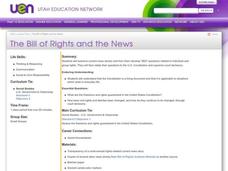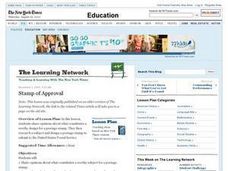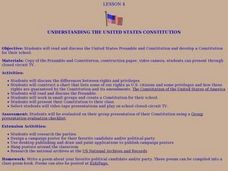Constitutional Rights Foundation
Plyler v. Doe: Can States Deny Public Benefits to Illegal Immigrants?
Illegal immigration is an ever-changing source of consistent controversy. A reading passage about the rights of undocumented workers and illegal immigrants—and the lack thereof—guides high schoolers into a mock trial activity. Three...
University of California
Equal Rights? The Women's Movement from Suffrage to Schlafly
If you've never heard of the Equal Rights Amendment, it's probably because there isn't one in the United States Constitution. Delve into the contentious history behind the ERA, its founders and supporters, and reasons for its political...
Curated OER
Compare/Contrast: The United States and Alaska Constitutions
Students compare and contrast the United States and Alaska Constitution. After reading each preamble, they identify the reasons for each constitution to be drafted and discuss what they reveal about citizens responsiblity in government....
Curated OER
The Bill of Rights and the News
Students examine current news stories and from them develop "BIG" questions related to individual and group rights. They then relate their questions to the U.S. Constitution and supreme court decisions.
Curated OER
History of Supreme Court
Learners study the role of the U.S. Supreme Court in U.S. history. They explore current events about the U.S. Constitution and discuss the Marbury v. Madison case from 1803. They identify the term "judicial review" and judicial...
Curated OER
American Focus on World Constitutions
Ninth graders describe essential components of a constitution and cite cultural factors affecting international law-making.
Curated OER
Fugitive from Labor Cases: Henry Garnett (1850) and Moses Honner (1860)
Students engage in the comparison of cases which demonstrate the increasingly volatile political crisis in the 1850s arising over the issue of slavery and the necessity for the enactment of the 13th, 14th, and 15th Amendments to the U.S....
Houghton Mifflin Harcourt
The Progressive Era: Muckrakers
Using Upton Sinclair's The Jungle, guide your class in the process of identifying unknown terms using context clues and formulating text-based answers. The lesson plan includes a useful worksheet incorporating scaffolding questions on an...
Curated OER
In My Other Life
Students explore various cultural identities. They conduct Internet research, develop a questionnaire that profiles information from their selected culture, and write a letter to a pen pal in the U.S. explaining what life in their...
Curated OER
The U.S. & Navajo Bills of Rights
Middle schoolers are introduced to the United States and Navajo Bill of Rights. In groups, they compare and contrast the two documents and take notes to share with the class. To end the lesson, they write in their journals about their...
Curated OER
School Bill of Rights
Students study the Bill of Rights. As a class, they create a "School Bill of Rights," with amendments. Students discuss the difference between rights and responsibilities and examine Supreme Court decisions dealing with the first ten...
Curated OER
The Rights of the Child
Students create a set of rights that promote safety and tolerance at the school site. In this Bill of Rights lesson, students read the U.N. Declaration on Rights of the Child. Student presenters lead a discussion of these rights and have...
Curated OER
Stamp of Approval
Students share opinions about what constitutes a worthy design for a postage stamp. They research a subject and design a postage stamp to submit to the United States Postal Service.
Curated OER
Rights and the Wyandotte Constitution
Young scholars use graphic organizers to analyze the Wyandotte Constitution. They read and discuss the Wyandotte Constitution, identify the civil rights granted to the people of Kansas and consider exceptions based on gender and race.
Curated OER
Understanding the United States Constitution
Students discuss the United States Preamble and Constitution. In this United States government lesson, students discuss the differences between rights and privileges and construct a chart that lists some of our rights as citizens....
State Bar of Texas
Gideon v. Wainwright
How does a trial begin without a lawyer for the defendant? The 1963 Supreme Court case Gideon v. Wainwright serves as the backdrop for the study of the rights of the accused. Scholars use a short video along with paired discussion and...
Administrative Office of the US Courts
Texas v. Johnson
Which right does the Constitution weigh more heavily: the sanctity of the American flag as a symbol of national unity, or the right to burn the flag in protest? The 1989 Supreme Court case of Texas v. Johnson explores a...
Curated OER
The Living Constitution
Tenth graders explore the Constitution as a "living document." After reading three specific cases, learners consider characteristics that make up a living document. In groups, they conduct guided research on each case. Pupils write a...
University of Arkansas
Promises Denied
"Promises Denied," the second instructional activity in a unit that asks learners to consider the responsibilities individuals have to uphold human rights, looks at documents that illustrate the difficulty the US has had trying to live...
iCivics
For The President, All In A Day's Work
How does the president of the United States get the authority to exercise his/her duties? What responsibilities and tasks go into a hard day's work for the president? Here is a lesson plan that includes several instructional materials...
Curated OER
George Washington: The Precedent President
Learners investigate precedents set during George Washington's term in office. They conduct Internet research, develop a list of the responsibilities of the President, match Washington's accomplishments with the list, and play a game.
Judicial Learning Center
Why Study Landmark Cases?
Why study landmark Supreme court cases? A helpful lesson offers a brief but valuable argument for the importance of these cases in the field of criminology. It introduces scholars to some key terms necessary for studying court cases and...
Judicial Learning Center
About Federal Judges
Not just anybody can do the job of a federal judge, but according to the United States Constitution just about anybody can be appointed. The lesson outlines the process and requirements for becoming a federal judge, focusing on the...
George Washington's Mount Vernon Estate & Gardens
George Washington: Centerpiece of a Nation
A neat Presidents Day activity, this lesson provides a culminating learning experience for upper elementary aged learners. After analyzing George Washington's, "A Display of the United States of America," your learners will conduct...

























